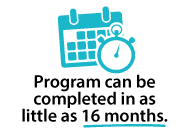Q. Can You Get Your Medical Specialties Degree Online?
A. Yes! Our online Medical Specialties program packs multiple medical skills into one degree, preparing you for a variety of careers in the healthcare industry, complete your program 100% online.
Back to top
Q. What Careers Will I Be Prepared to Work in When I Complete my Medical Specialties Degree?
A. Our medical specialties associate degree program prepares you for five different in-demand healthcare careers: medical billing, medical assisting, medical coding, pharmacy technician, and patient care technician.
Back to top
Q. What Is the Best Two-Year Medical Degree?
A. Our medical specialties program is a unique medical associate degree option. While some undergraduate schools offer healthcare programs to teach you one career over a few years, our two-year medical programs will prepare you for five types of in-demand healthcare jobs. Our self-paced online classes teach you not just one specialty but several subspecialties as well. Throughout our program's courses, students will learn information about the latest in science, technology, and medicine.
Back to top
Q. Which Medical Specialties Have the Best Future?
A. Medical specialty careers across the board are expected to increase in demand through 2033. Of those covered in our Medical Specialties program, Medical Assistant jobs are predicted to grow by as much as 15%1. There's no better time to start earning your online associate degree for Medical Specialties!
Back to top
Q. What Is the Fastest Medical Degree to Get?
A. Whether you want to be a medical technologist, administrator, or Medical Assistant, a two-year college education will typically be needed to earn an AAS degree. "Fastest," "quickest," and "easiest" all sound tempting when you're planning for the future, but to become a truly great specialist in your field, you have to put in the work. Since our online programs are self-paced, you can complete your studies as quickly as you are capable.
Back to top
Q. How Long Does It Take to Get a Healthcare Management Degree?
A. A healthcare management program can take up to four years of schooling to meet all of the necessary requirements.
Back to top
Q. Do I Need to Get Certified?
A. Whether certification is required by a particular employer may vary, but it's always a good idea. Thankfully, once you graduate from U.S. Career Institute's Medical Specialties course with your associate degree, you'll be well-positioned for nine different certification exams. Graduates of our online Medical Specialties associate degree program can pursue three certification options in medical coding and billing, two certifications in medical assisting, two certifications for pharmacy technician, one for patient care technicians and one for electronic heath records.
Back to top
Q. How Much Does the Medical Specialties Program Cost?
A. Tuition for this program is $1,689 per semester when you pay in full. Payment plans and financing are also available.
Back to top
Q. How Much Can I Earn?
A. According to information from the Bureau of Labor and Statistics, the average salaries for these professions are:
Medical Assistant - $42,0001
Medical Coding - $48,7802
Medical Billing - $47,0703
Pharmacy Technician - $40,3004
Back to top
Q. Is U.S. Career Institute Accredited?
A. Yes! U.S. Career Institute is Accredited by the Distance Education Accrediting Commission. The Distance Education Accrediting Commission is listed by the U.S. Department of Education as a recognized accrediting agency.
Back to top





